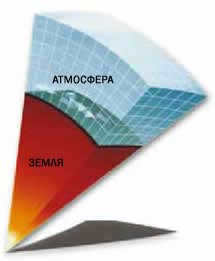Description of the earth’s atmosphere: what it is made of, the presence of gases, layers with photos, climate and weather of the third planet in the solar system.
For young children, it is important to note that the Earth is the only planet in our system that has a livable atmosphere. The atmosphere not only contains air, but also provides protection from excessive heat and solar radiation. It is crucial to explain to children that this system is incredibly well-designed as it allows the surface to warm up during the day and cool down at night, while maintaining a balanced temperature.


This photograph depicts the Earth’s atmosphere and the moon. It was captured by astronauts on July 31, 2011, while aboard the International Space Station.
Let’s start by explaining to children that the Earth’s atmosphere extends 480 kilometers, with most of it being 16 kilometers above the surface. As we go higher in altitude, the pressure decreases. At sea level, the pressure is 1 kg per square centimeter. However, at an altitude of 3 km, it drops to 0.7 kg per square centimeter. Breathing becomes more difficult in such conditions, as the air becomes thinner. You might have experienced this if you’ve ever been on a hike in the mountains.
- Nitrogen constitutes 78% of the Earth’s atmosphere.
- Oxygen makes up 21% of the atmosphere.
- Argon accounts for 0.93% of the air.
- Carbon dioxide makes up 0.038% of the atmosphere.
- In addition, there are small amounts of water vapor and other gas impurities.
Explanation of Earth’s Atmospheric Layers for Kids
Parents or teachers at school should remind you that the Earth’s atmosphere is divided into five layers: the exosphere, thermosphere, mesosphere, stratosphere, and troposphere. Each layer gradually thins out until the gases eventually dissipate into space.
The troposphere, which is located closest to the Earth’s surface, comprises half of the Earth’s atmosphere and has a thickness ranging from 7 to 20 km. Due to its proximity to the Earth, the air in the troposphere becomes warmer. Additionally, this is the layer of the atmosphere where most of the water vapor and dust are gathered. It’s not uncommon for children to be amazed by the fact that clouds can be found floating at this level.
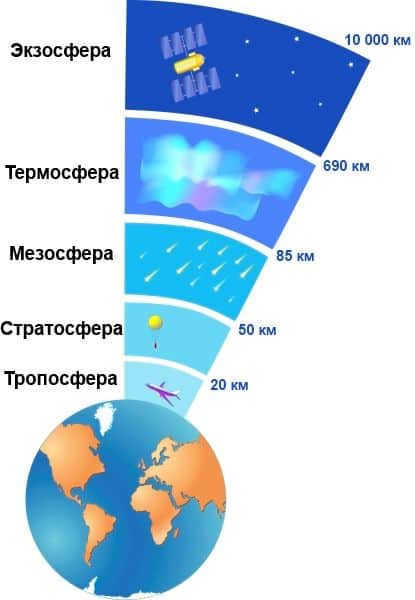
The stratosphere begins at the troposphere and extends 50 km above the Earth’s surface. In this region, there is a significant amount of ozone, which helps to heat the atmosphere and protect it from harmful solar radiation. The air here is much thinner than at sea level and lacks moisture, making it an ideal environment for airplanes.
The mesosphere, which spans from 50 km to 85 km above the Earth’s surface, is characterized by its frigid temperatures. The top of the mesosphere, known as the mesopause, is the coldest place in the Earth’s atmosphere, reaching temperatures as low as -90°C. It is a challenging region to study due to the difficulties in accessing it with jet airplanes and satellites. However, scientists have determined that this is where meteors typically burn up upon entering the Earth’s atmosphere.
The thermosphere is a region of the Earth’s atmosphere that extends from 90 kilometers to between 500-1000 kilometers above the Earth’s surface. The temperature in this region can reach up to 1500°C. It is an important part of the Earth’s atmosphere, especially when explaining it to children. This is because it is the location of the space shuttle and the International Space Station. It is also the region where the auroras, such as the aurora borealis, form. This phenomenon occurs when charged cosmic particles interact with atoms and molecules in the thermosphere, causing them to move to a higher energy level. As a result, we are able to see these particles as beautiful photons of light.

The exosphere, which is the highest layer, is where the atmosphere meets space. It is composed of extremely thin hydrogen and helium particles that are widely dispersed.
Explanation of Earth’s climate and weather for kids
Let’s talk about this in a way that young children can understand. The Earth is able to support a wide variety of living species because it has different climates in different regions. For example, the poles are extremely cold, while the equator is warm and tropical. It’s important for kids to know that regional climate refers to the average weather conditions in a specific area over a period of 30 years. Although the weather can change in a matter of hours, it generally remains consistent.

The answer to the question of why the sky is blue is quite simple and straightforward. The Earth’s atmosphere contains air that absorbs the sunlight it receives from the Sun. The reason why the sky appears blue is due to the fact that blue light scatters more easily than other colors due to its shorter and wider wavelengths. As a result, blue light spreads throughout the air, giving the sky its characteristic blue color.
However, if you are interested in delving deeper into the topic of Why the sky is blue, we can provide you with a more comprehensive scientific explanation, along with other interesting facts.
The structure of the Earth’s atmosphere
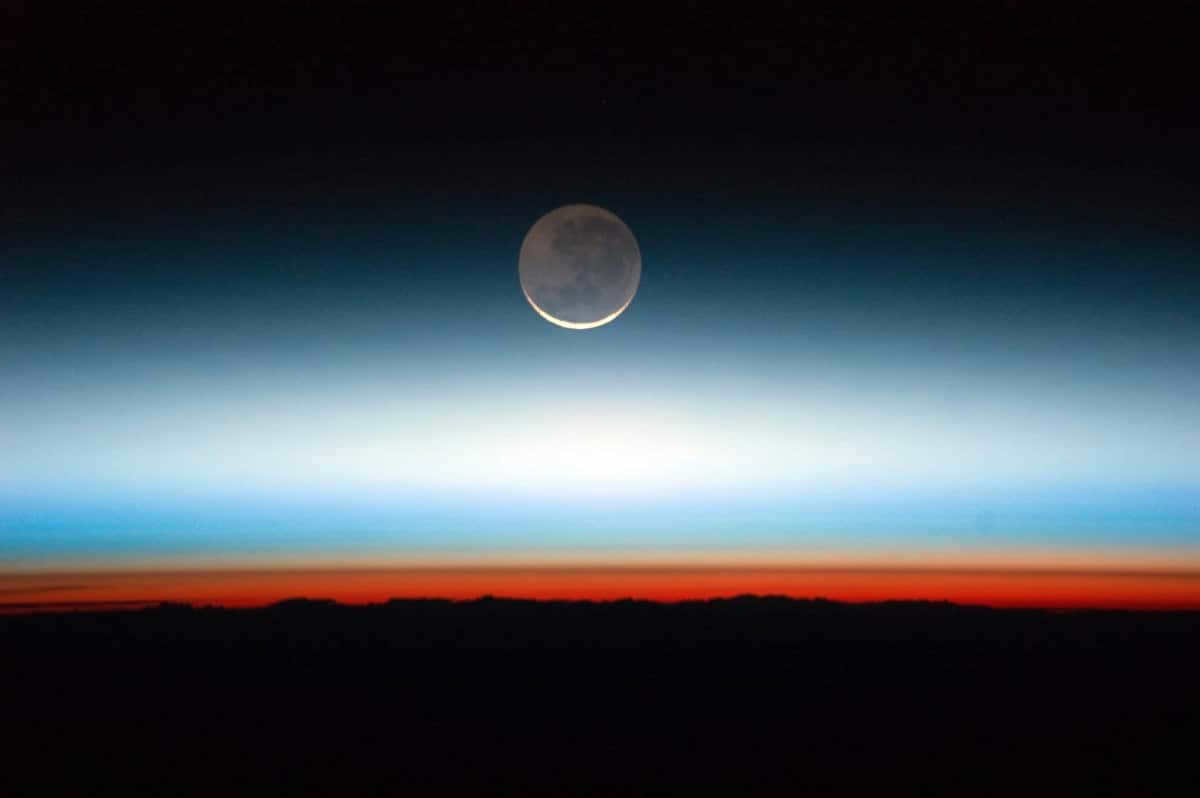
To begin with, let us provide a concise overview of the Earth’s atmospheric composition. The color of the sky that we observe is directly influenced by the composition of the atmosphere.
The atmosphere is the outermost layer of our planet, composed of a variety of gases in varying proportions, making it the lightest layer. These gases play a crucial role in supporting all forms of life on Earth. Additionally, the atmosphere also contains suspended solids and liquids, both natural in origin and those produced through human activities. Nitrogen, oxygen, carbon dioxide, argon, noble gases, methane, hydrogen, nitrous oxide, carbon monoxide, ozone, water vapor, and aerosols are among the gases that comprise the atmosphere. Below, we will provide a brief overview of these essential components.
The majority of the Earth’s atmosphere is made up of nitrogen, accounting for about 4/5 of its composition. The remaining 1/5 is primarily composed of argon. Nitrogen is the most abundant component of the atmosphere in terms of volume.
Nitrogen is an essential element for soil fertility. It is a highly abundant gas in the atmosphere, but plants are only able to absorb a small fraction of it, about 1%. This is because nitrogen is a gas that does not easily react with other gases and cannot be burned. Therefore, specific bacteria must break down nitrogen molecules in order for plants to be able to utilize them.
Oxygen
Oxygen is the second most abundant element in the universe. It comprises 21% of the gas volume, but it also plays a vital role in the respiration and growth of all living organisms. Its presence is essential for all combustion processes to occur.
For all living things, oxygen is the most crucial chemical element. Oxygen makes up more than a quarter of all molecules in living organisms. This high abundance enables oxygen to readily bond with other elements, forming new molecules.
Carbon dioxide
Carbon dioxide (CO2) is one of the numerous gases present in the atmosphere. Its concentration in the atmosphere can vary depending on time and location. CO2 is generated through the decomposition of organic matter, the respiration of living organisms, and the combustion of fossil fuels. It can also counterbalance the process of photosynthesis in both plants and oceans.
Before the Industrial Revolution, the air contained 280 parts per million of carbon dioxide. However, the levels of this greenhouse gas have significantly risen over time due to the decline in plant life. Currently, the air has an average of 410 parts per million of carbon dioxide. This is because various factors contribute to more than half of the 410 parts per million present in the atmosphere.
Methane
Prior to the industrial revolution, the composition of our atmosphere included approximately twice the amount of methane that is present today. Presently, it is estimated that the atmospheric concentration of methane stands at around 2 parts per million.
When compared to carbon dioxide, methane possesses a greenhouse effect that is 25 times more potent. Regrettably, the contribution of carbon dioxide to the atmosphere’s greenhouse effect is only 17% of the total. This discrepancy arises from the fact that carbon dioxide has a much greater impact at lower concentrations.
The presence of ozone in the atmosphere provides a shielding effect against the harmful ultraviolet rays emitted by the sun. Without this protective layer, the sun’s radiation would have detrimental effects on all living organisms on Earth. The concentration of ozone in the atmosphere fluctuates with the changing seasons and is influenced by factors such as altitude and latitude. Typically, the ozone layer is found at an elevation of 15 to 35 kilometers.
Aerosols
Aerosols play a crucial role in the creation of condensation nuclei, which are essential in cloud formation. Additionally, their presence in the atmosphere contributes to air pollution. Certain aerosols are categorized as suspended particles, existing in liquid or solid form. Organic matter, dust particles, smoke, ash, and salt crystals are among the sources of aerosols. Natural phenomena, like the movement of ocean waves, can also generate aerosols.

Rainbows encompass the entire spectrum of sunlight. Sunlight may appear white, but it actually contains all the colors of the rainbow.
A prism is a unique crystal shape that, when sunlight passes through it, separates the light into its individual colors.
The NASA website has a section specifically for children called the Land of Magic Windows. It explores the different types of light that exist beyond what we can see.
Various light sources travel in different wave lengths. Blue light travels in shorter waves, while red light travels in longer waves. Light itself moves in waves, similar to the way energy circulates in ocean waves.
If light does not pass through an object, it will travel in a straight line. However, if it does pass through an object, several events can occur:
- It is like the reflection of things, such as when mirrors reflect objects or when a pond reflects the sky.
- It is similar to the phenomenon of doubling, like when prisms and other objects refract light.
- This phenomenon is diffuse, just like the scattering of gases in the Earth’s atmosphere.
The Earth’s atmosphere contains a variety of gases and particles that scatter light in all directions upon entering the atmosphere. Blue light is scattered more than other colors because it interacts with smaller molecules in the atmosphere and has shorter wavelengths. This scattering of blue light is what causes us to see blue skies most of the time.
At times when the sun hangs low in the sky, the hue of the heavens takes on a white or faint blue tint. The illumination, having traversed a great distance through the atmosphere, has been dispersed and redirected multiple times by air particles. Additionally, the Earth’s surface has contributed to the reflection and scattering of light. Upon recombining all these various hues, the result is a predominance of white and a decrease in the intensity of blue.
Why is the sunset red if the sky is blue?

When the Sun descends towards the horizon, it casts its glow on various layers of the atmosphere, causing the majority of the blue light to scatter. However, the red and yellow light remain unaffected, allowing us to perceive this phenomenon with our naked eyes.
What is the hue of the Martian sky?
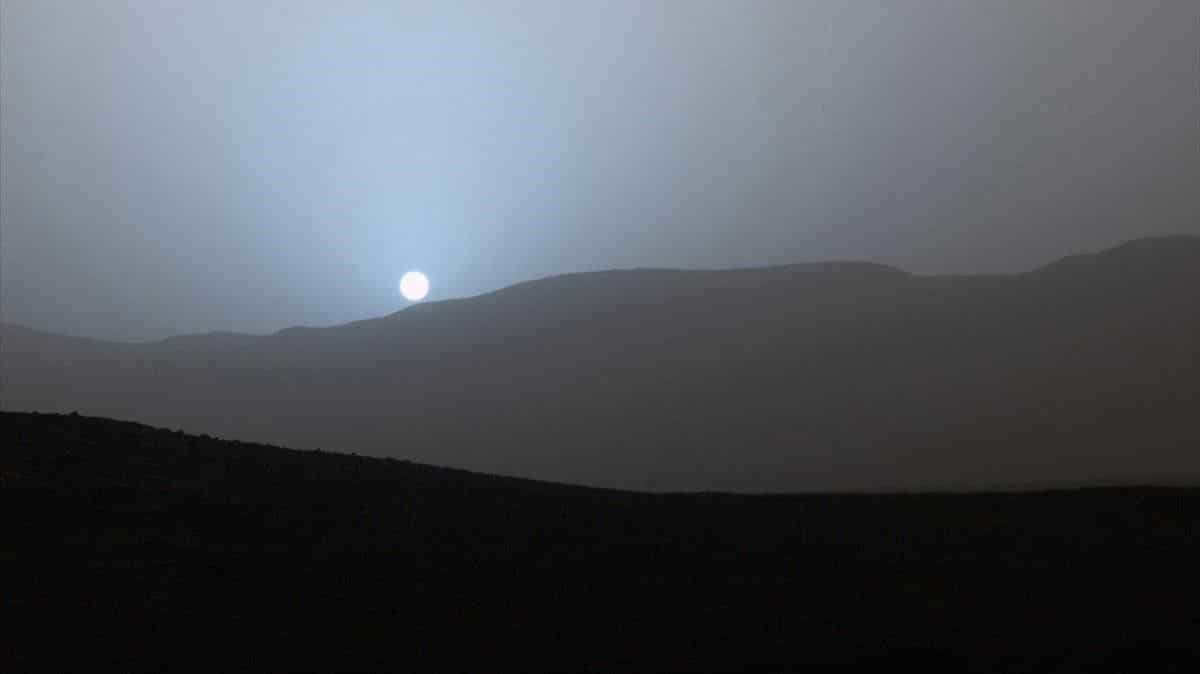
Mars possesses a thin atmosphere that is composed of carbon dioxide and is filled with minuscule dust particles. The composition of the Martian atmosphere causes light to scatter in a distinct manner compared to Earth’s atmosphere, which consists of gases and larger dust particles.
During the daytime on Mars, the sky takes on an orange or red hue, while at sunset, it appears bluish gray. NASA has captured images of this phenomenon through their rovers and landing modules.
This article adheres to our editorial ethics guidelines. If you spot an error, please click here to report it.
Full Article Summary: postpost ” environment ” Why is the sky blue?
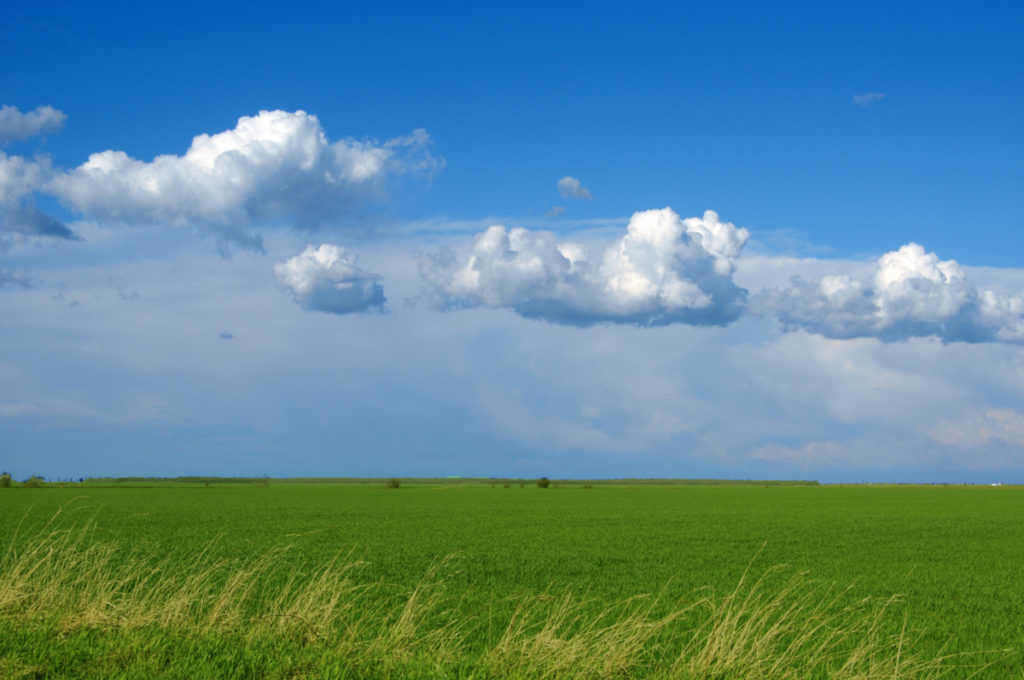
Why does the sky appear blue? – This is a common question that many people ask. The simple answer to this question is that the Earth’s atmosphere and sunlight are responsible for the blue color of the sky. If there was no atmosphere, the sky would be black during the day, just like it is at night.
The sky appears blue during the day and black during the night. The main difference between day and night is the presence of sunlight, which is absent at night when we are on the side of the Earth that is facing away from the sun. This provides us with our first clue as to why the sky appears blue – sunlight has an impact on its color.
The color of the sun is white, as are its rays, which must traverse the vast distance of approximately 150 million kilometers from us to reach us. Describing the sun as white can be somewhat misleading, as white is not a single color, but rather a combination of multiple colors. In more technical terms, white is a polychromatic color comprised of a continuous spectrum of colors. This is the true nature of the sun’s color.
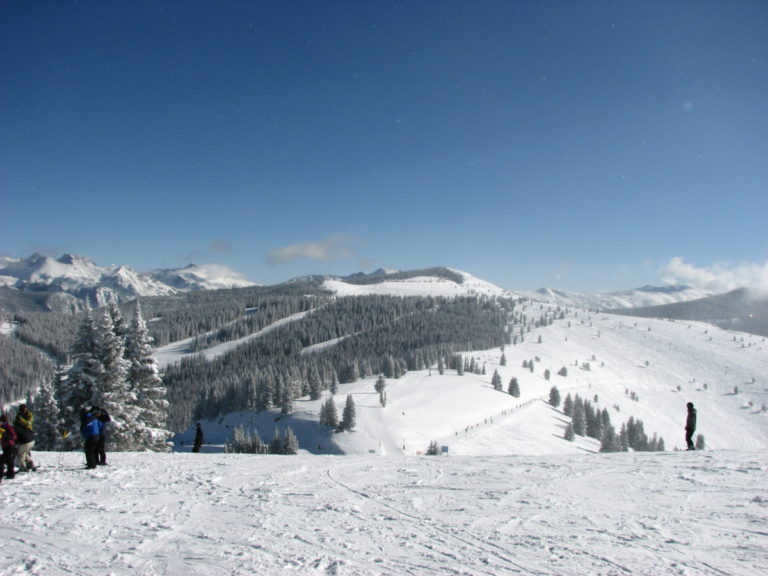
A prism-like device can separate white rays of light into a beautiful array of vibrant colors. This enduring phenomenon occurs when sunlight, which appears white, is dispersed into a spectrum of colors by raindrops.
To comprehend why the sky appears blue, we must also consider light as a wave. In essence, light is an electromagnetic radiation or wave with a specific wavelength or frequency.
Visible light waves (which are detected by our eyes and transformed into images by our brains) range in wavelength from approximately 400 to 700 nanometers. In terms of color, waves of specific lengths represent different colors. For instance, red light has a wavelength of about 625 to 740 nanometers, green light falls within the range of 500 to 565 nanometers, blue light spans from 380 to 440 nanometers, and violet light also falls within the range of 380 to 440 nanometers.

When it comes to the question we’re addressing here, it’s essential to bear in mind the following:
- Compared to other visible colors of light, blue and violet light have the shortest wavelengths.
- The sun travels through the vacuum of space before reaching our eyes and the Earth’s atmosphere. Along the way, fascinating phenomena occur that ultimately give the sky its blue hue.
What exactly is the Earth’s atmosphere? It’s the Earth’s protective layer, composed of a variety of gases (and it exists because of the Earth’s strong gravitational pull). We are all aware that one of these gases is oxygen, which is vital for human survival.
However, it may come as a surprise to many individuals that the majority of the atmosphere is composed of nitrogen. Oxygen makes up approximately 21% of the atmosphere, while nitrogen accounts for a whopping 78%. The interaction of sunlight with nitrogen and oxygen molecules in the atmosphere is what gives our skies their blue color.
Light scattering in the atmosphere
As sunlight enters the Earth’s atmosphere, it interacts with nitrogen and oxygen molecules, leading to a phenomenon known as scattering or Rayleigh scattering (named after Lord Rayleigh, who first described it in 1871). This scattering occurs when the size of the particles on which light is scattered is smaller than the wavelength of the light. In the case of the Earth’s atmosphere, nitrogen and oxygen molecules are much smaller than the wavelength of visible sunlight, resulting in scattering.

The significance of Rayleigh scattering lies in its dependence on the wavelength or color of the light: shorter wavelengths scatter the most, while longer wavelengths scatter the least (if, by chance, with the fourth power of the wavelength). For instance, typical blue light scatters approximately five times more efficiently than red light.
When the sun’s rays traverse the atmosphere, violet rays scatter the most, followed by blue rays. One can imagine this as violet and blue light “escaping” from the white sunlight, rearranging themselves, and scattering throughout the sky to eventually reach the eye, resulting in the sky appearing colored. However, despite violet light being more scattered than blue light, the sky appears blue rather than violet.
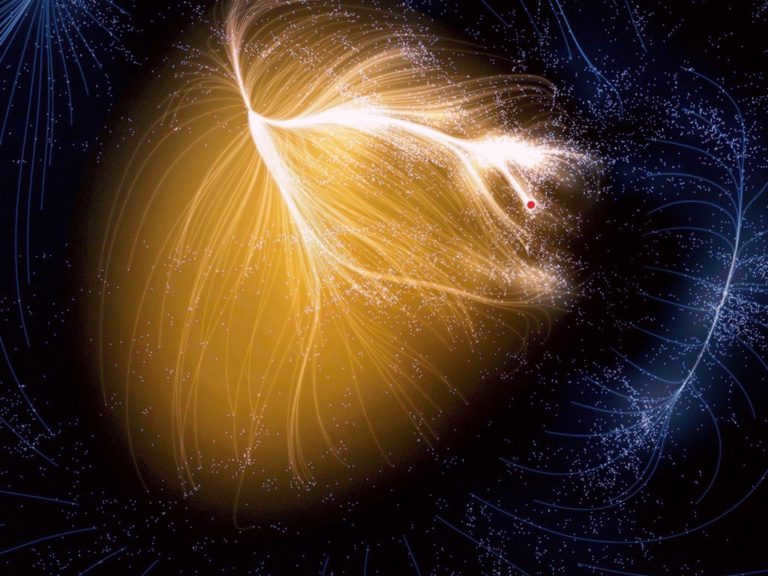

There are a couple of factors at play here. Firstly, it’s important to note that the solar spectrum contains fewer shades of violet compared to blue. Secondly, our eyes are more receptive to blue than violet. This is why we perceive the sky as being blue. However, if there was no atmosphere, the sky would appear black because there would be no molecules scattering sunlight across it.
What causes the red color of the sky during sunrise and sunset?
During sunrise and sunset, the sunlight has to travel a longer distance through the atmosphere compared to when the sun is directly overhead. As a result, the shorter wavelengths of light, such as violet and blue, are scattered multiple times in different directions and do not reach our eyes. Additionally, if there are dust and smog particles present in the atmosphere, they can contribute to further scattering and enhance the reddening effect, leading to the creation of stunning sunsets.
The atmosphere, which is the gas envelope of the planet and the near-Earth part of outer space, is divided into five different layers and seven levels:
- 1. Troposphere
- 2. Stratosphere
- 3. Mesosphere
- 4. Ionosphere (Karman Line)
- 5. Thermosphere
- 6. Exosphere
2. The stratosphere, also known as the ozone layer, provides essential protection against harmful ultraviolet rays. This layer is located at an altitude of 11-50 km. In the stratosphere, solar radiation causes gas molecules to break down into atoms. As the altitude increases, the temperature also rises steadily, which is the opposite of what occurs in the troposphere. If a spacesuit or capsule were to depressurize at extreme altitudes, there would be a dangerous effect known as “ebullism,” where the blood would literally boil. However, stable air currents with speeds of up to 300 km/h create ideal conditions for supersonic airplanes to fly (modern airliners typically prefer to cruise at an altitude of 20 km).
3. The mesosphere is a layer of the atmosphere where asteroids burn up upon entering. The meteor trail left by these “falling stars” is often visible in the night sky.
3 The mesosphere is the region in which asteroids incinerate (their meteor trail of “shooting stars” is visible in the nocturnal heavens). This region is situated at an altitude of 50-90 kilometers from the Earth’s surface. The mesosphere is characterized by its frigidity and extreme rarity – it is akin to a “Dead Zone”: the air density is too low for aerodynamic aviation, yet still relatively high for man-made satellites. The boundary between the mesosphere and thermosphere, known as the pause, maintains a temperature of -90°C (183.15K).
The Ionosphere is a layer of the atmosphere that becomes ionized by radiation from the Sun. It consists of a layer of quasi-neutral plasma. The ionization process is already significant at an altitude of 60 km, but it reaches its peak at around 150-200 km above the Earth’s surface. Although it is not considered a separate layer, the ionosphere is generally regarded as the upper part of the Mesosphere and the lower part of the Thermosphere.
In international terminology, the boundary between Earth’s atmosphere and Space is known as the Karman Line, named after the scientist Theodore Von Karman. This boundary is located at an altitude of 100 km. At this height, the speed of an aircraft must exceed the first cosmic speed, and the concept of the “sound barrier” becomes irrelevant as the aircraft is propelled solely by jet forces.
The thermosphere, also known as the heterosphere, encompasses an altitude range of several hundred kilometers above the Earth’s surface, reaching up to approximately 800 km. In this region, gases are not uniformly distributed and do not mix well; instead, they are stratified and layered. The temperature gradually rises as altitude increases, peaking at around 300 km (equivalent to approximately 1226.85°C or 1500 K). Beyond this point, the temperature remains constant. The thermosphere is the region where artificial satellites orbit the Earth and where phenomena such as the polar lights (caused by ionization of atmospheric oxygen) occur. Flights that venture above the Karman line in this region typically follow ballistic trajectories. Launching a satellite into a higher orbit beyond the thermosphere requires a greater amount of energy.
5. The exosphere, also known as Earth’s corona, is the layer where the gas shell escapes into space. The dissipation process, which involves the leakage of particles into interplanetary space, occurs at a high rate and can reach speeds of up to 11.2 km/sec. This layer has the ability to expand up to ten times its original size, reaching a diameter of 100 thousand kilometers. Other planets, such as Venus, have different expansion capabilities, with its corona expanding up to 200 thousand kilometers. The height at which the exosphere begins depends on solar activity. At the edge of the exosphere, the pressure exerted by solar radiation on hydrogen atoms is stronger than the force of Earth’s gravity. This boundary is located at an altitude of approximately 190,000 km, which is half the distance to the Moon.
Note: Planets and celestial bodies with extremely thin atmospheres, such as Mercury and the Moon, have atmospheres that are entirely composed of exospheres.
Muslim Declarations
The ensuing verses serve as the foundation of this extraordinary phenomenon:
He is the Creator of everything on Earth, and then He looked up to the sky and made it into the seven heavens. He is knowledgeable about all things. – Quran, 2:29
Then He turned to the sky, which was filled with smoke, and commanded it and the Earth, “Come willingly or unwillingly.” They said, “We will come willingly.” He created the seven heavens in two days and assigned to each heaven its duties. We have adorned the lower heavens with stars and are protecting them. This is the predetermined plan of the Mighty, the All-Knowing. – Quran, 41:11-12
The renowned author Harun Yahya provides the following interpretation of these verses:
The term “sky,” which is mentioned in numerous verses of the Quran, is used to refer to both the entire universe and the atmospheric sky above the Earth. In other words, the Quran states that the sky is composed of seven layers: < … > 1) Troposphere 2) Stratosphere 3) Mesosphere 4) Thermosphere 5) Exosphere 6) Ionosphere 7) Magnetosphere.
Analysis
Duality of the term “sky”
Harun Yahya uses the term “sky” to refer to either the entire universe or the Earth’s atmosphere. While it would be acceptable if the term was consistently used in one sense or the other, there is a contradiction in ayats 41:11-12. When trying to prove the existence of a seven-layer atmosphere, Harun interprets the Earth’s atmosphere as the sky. However, when trying to demonstrate the origin of the universe from “hot smoke,” the term “sky” takes on a broader meaning – “the universe.” This inconsistency is present in the same ayat 41:11, which is used to support both arguments.
It is evident that the presence of one “miracle” negates the other. In this particular scenario, the “miracle” of the seven layers of the atmosphere contradicts the “miracle” of the universe’s creation from “hot smoke” due to the employment of the same ayat with the same word, which cannot undergo a change in meaning from one Harun article to another.
Another article delves into the following ayat: “He created seven heavens one above the other”, where the term “sky”, based on the context of the article, once again encompasses the entire universe. Hence, the selective nature of the word “sky” becomes evident: Harun Yahya simply selects the meaning that suits his objectives without providing an explanation as to why in one ayat “sky” refers to the universe while in another it refers to the atmospheric layers.
Selectivity of layers
Practically, the Earth’s atmosphere is partitioned into a mere 5 layers:
In this enumeration, Harun Yahya incorporated the magnetosphere despite it not being an atmospheric layer, but rather a region characterized by indications of magnetization on a celestial body. Concerning the ionosphere, it encompasses the thermosphere and partially the mesosphere and exosphere, thus already accounted for in the aforementioned five layers of the Earth’s atmosphere.
Contradiction between hadith and other verses
The interpretation of the seven heavens as the seven layers of the earth’s atmosphere goes against the teachings of the following reliable hadith:
Al-Abbas ibn Abdul-Muttalib narrates that once the Prophet of Allah (peace and blessings be upon him) asked us, “Do you have knowledge about the distance between the sky and the earth?” We responded, “Only Allah and His Messenger know best.” The Prophet (peace and blessings be upon him) then stated: “The distance between them is equivalent to five hundred years, and each heaven is also separated by five hundred years.” Each heaven extends over a distance of five hundred years as well. The sea lies between the seventh heaven and the Throne, with a depth equal to the distance between the heavens and the earth. However, Allah Most High is above it, and nothing is concealed from Him regarding the actions of the sons of Adam!”
(Ahmad 1/206, Abu Dawud 4723, at-Tirmizi 3320, Ibn Majah 193, al-Bazzar 1310)
Evidently, the vastness between the Islamic seven heavens is immense, as it was estimated to be “five hundred years”, a fact that contradicts the comparably small size of the Earth’s atmosphere (in relation to the universe).
The tale of Muhammad’s ascension (miraj). According to this account, the prophet encountered Adam in the initial heaven, Yahya and Jesus in the second heaven, Yusuf in the third heaven, and so forth. Therefore, all of these encounters must have occurred within the troposphere, stratosphere, mesosphere, and the remaining layers of the earth’s atmosphere?
< … > Upon reaching the lowest heaven, I witnessed the presence of Adam < … > As I ascended to the second heaven, I encountered Yahya and Isa. … > Continuing my journey to the third heaven, I encountered Yusuf < > … > Progressing to the fourth heaven, I encountered Idris < > … > Advancing to the fifth heaven, I witnessed the presence of Harun < > … > Upon reaching the sixth heaven, I encountered Musa < > … > Finally, upon reaching the seventh heaven, I witnessed the presence of Ibrahim < > … > – Sahih al-Bukhari (Abu Abdullah Muhammad ibn Ismail al-Bukhari) , No. 1513 (Russian)
According to the Qur’an, the stars are only adorned in the nearest sky, which is where Muhammad, as per the legend of the ascension, encountered Adam:
We have adorned the nearest sky with the beauty of the stars. – Quran , 37:6
Indeed, We have adorned the nearest sky with lights and positioned them as projectiles against the devils. We have prepared for them a torment in the Blaze. – Quran , 67:5
If the Qur’an truly predicted a seven-layered atmosphere, the stars would be situated at the same level as the clouds.
Mention of a sky consisting of seven layers is not only found in the Qur’an, but also in Judaic religious texts:
Originally, the Shekhinah resided in the lower world; however, due to various sins committed by notable individuals throughout history, she was banished to each subsequent layer. For instance, Adam’s sin caused her to be exiled to the first heaven, while Cain’s sin resulted in her banishment to the second heaven. Similarly, Enosh’s generation caused her to be confined to the third heaven, the generation of the Flood caused her to be relegated to the fourth heaven, and so on. Finally, during Abraham’s time, the Egyptians were responsible for her placement in the seventh and final heaven. Interestingly, both Abraham and Moses played key roles in bringing the Shekhinah back to lower realms. Abraham brought her down to the sixth heaven, while Moses successfully returned her to the earthly realm. This information can be found in the Bereshit Raba 19:7, a religious text that predates the Qur’an by several centuries, having been compiled in the 5th century CE. Therefore, it is evident that the Qur’an is not the first religious text to recount the story of the seven heavens.
Errors in scientific research
The ayats ( 2:29 and 41:10-12) discussed in this article not only lack a miraculous aspect, but also contradict scientific evidence. According to these ayats, the order of creation was that the earth was formed first, followed by the sky (the universe). This viewpoint is supported by various tafsirs:
The specific ayat [ 41:9–12 ] provides evidence that Allah initiated the creation with the earth, and after completing its creation, He proceeded to create the seven heavens. This can be likened to the construction of a building, where the construction begins from the bottom and progresses upwards. Commentators have also mentioned this, and we will further explain it by Allah’s will. "He is the One Who created for you all that is on the earth."
This means that Allah created the earth before the heavens. When He created the earth, smoke emerged from it, as He described it:
"Then He turned to the sky, which was smoke. And then He turned to the sky and made it seven heavens."
Meaning, one heaven above another, and likewise, He created seven earths, one below another. This ayat confirms the fact that the earth was created prior to the heavens, as mentioned in the surah “The Explained” (the ayats of which we have cited above).
The notion of the earth being created before the heavens is also mentioned in a hadith reported by al-Bukhari from Ibn Abbas (may Allah be pleased with him) when he was asked about this matter. He responded that the earth was created before the heavens but was later spread out after the creation of the heavens. This was the viewpoint of many early and later experts of tafsir. We have provided further elaboration on this in the surah of the uprooters.
“Allah is the creator of the seven heavens and the earth, just as it is mentioned in Surah ‘The Diviners’ (12)”.
According to the Quran, the earth’s atmosphere is composed of seven layers, which are separated by transitional layers. The Encyclopedia Americana (9/188) also confirms the existence of seven atmospheric layers based on temperature:
Layer 1: Troposphere – This layer occupies the majority of the atmosphere and extends to an average height of 8 km at the poles and 17 km at the equator. The temperature in the troposphere decreases by an average of 6.5 degrees Celsius for every kilometer of altitude. The troposphere is separated from the stratosphere by a transitional layer called the tropopause, which has fast air currents and a constant temperature of -57 degrees Celsius.
The third layer of the Earth’s atmosphere is known as the mesosphere: It extends up to an altitude of 85 kilometers and experiences extremely low temperatures, dropping to -100 o C.
The fourth layer is called the thermosphere: In this layer, the temperature rises rapidly.
The fifth layer is referred to as the ionosphere: The gases in this region are in an ionized state. The ionosphere plays a crucial role in enabling communication on Earth by reflecting radio waves.
The sixth layer is known as the exosphere: It is situated at an altitude of 500-1000 km. The characteristics of this layer are greatly influenced by solar activities.
The seventh layer is called the magnetosphere: It is a vast region enveloped by the Earth’s magnetic field, resembling a huge void. Charged subatomic particles are trapped in the Van Allen belts within this region.
Similarly, the Earth’s crust is also composed of seven layers, as stated in the same source:
"In truth, He brought forth the heavens and the earth. He envelops the night with the day and wraps the day around the night…" (Surah "The Crowds"; 5)
The descriptions used in the verses of the Qur’an to explain the universe also capture significant attention. For instance, the Arabic term "taqveer", which is translated as "to wrap" in the aforementioned verse, literally means "to wrap something around" (The Arabic dictionary employs this term to describe actions involving a circular object, such as "to wrap a turban around one’s head").
Therefore, the phrase "encircles the day with the night and encircles the night with the day" as stated in the previous verse enables us to infer the form of the Earth itself. This is because the described phenomenon can only occur if the Earth is spherical in shape. Hence, the Qur’an, revealed in the 7th century, provides evidence for the spherical shape of the Earth.
It is important to remember that during that period, astronomy had a completely different understanding of the Earth. The prevailing belief was that the Earth was flat, and all scientific calculations and theories were based on this misconception. However, the Quran contains no references that align with this erroneous knowledge of the time. On the contrary, the verses of the Quran provide information that has only been discovered in modern times. When describing the universe, the Quran uses incredibly accurate and precise language, reaffirming its status as a divine revelation from Allah Almighty.
Imagine if I were to inform you that every individual who abandons something that was once of great significance to them experiences a sense of being the ultimate failures in the world. They put on a smile. They observe the world with self-assurance, with a feeling of having gained a wealth of life experience. With a sense of accomplishing their goals and realizing their long-held dreams. With a sense of knowing what steps to take next. They claim to be doing well. They assert that they are happy and proud of their past, which has provided them with numerous amazing moments and achievements. They state that everything has an ending, and one must learn to live with it, and they have. Even though you cannot hear it, they say this to themselves. You cannot hear it, but an inner voice responds to them, mockingly suggesting that, if you were to examine their emotions, it is truly astonishing why these failures have not yet decomposed in the damp soil. They experience hatred. Hatred towards the unfortunate circumstances that have unfolded. Hatred towards the painful memories that surge like waves of scorching seawater, causing real-time short-circuiting. Hatred towards time, which fails to heal anything. Self-loathing. For losing everything. They feel bitterness. A type of bitter taste that travels down their entire throat, reaching their stomach and seeping out through the pores of their skin and in the form of sparse droplets from their eyes. This bitterness consumes their entire being, dissolving the remnants of the shattered invisible walls. They feel emptiness. They feel emptiness better than anyone else because it resides within them. Because it surrounds them. Because it exists in the measured movement of the second hand on the black face of the clock. Because it is present in every cup of cooling tea. Because it resides in the closet next to the box of items that were once useful but are now unnecessary. Because it shares their bed with them at night. Because they have something to compare it to. They experience all the colors of the sky. All its hues, all its layers, one above the other, stretching towards infinity. They gaze at the sky for hours on end because it is vast and boundless, because it is a colossal canvas where one corner showcases a sunset while the other reveals a dawn, because the dark storm clouds over the suffocating city carry a fraction of the water from the tropical rains in warm equatorial nations, because that immense yellow sphere, up there, high above, will one day obliterate our insignificant planet in a few billion years. Because now is the time to perceive what others fail to notice in their haste. What if I were to inform you that half of you have no comprehension of what I am currently discussing? What if I were to apologize? What if I were to admit that it is my fault? Would it all vanish? Would all the emotions I am experiencing dissipate? Would the ache in my chest cease? Would everything I lost be restored, and would I have the ability to rectify it? I can perceive all the layers of the sky. My jaw drops, and I release this silence, I tear my throat with screams, I kick the grass, I scrape the ground with my knees while the sky gazes at me.
He – The One Who created all things on the earth to fulfill your needs. After that, He organized the heavens and brought into existence the seven heavens. Truly, He has knowledge of all things. (Surah “The Cow,” 2:29)
Then He established the creation of the sky, which was originally a haze of smoke; … He established the seven heavens in two days, and He decreed His command for each of the heavens. (Surah “Explained,” 41:11-12)
The term “sky,” which is mentioned in various verses of the Qur’an, is used to refer to both the entire universe and the atmospheric sky above the earth. In other words, the Qur’an states that the sky is composed of seven layers.
Currently, scientists have already determined that the earth’s atmosphere is composed of distinct layers stacked on top of each other. The layers are classified based on their chemical composition and temperature. It has been observed through experiments that the earth’s atmosphere consists of a total of 7 layers. Meteorology relies on a model called the Limited Fine Mesh Model (LFMII), which divides the atmosphere into 7 layers, to make weather forecasts for the next 48 hours. In the field of modern geology, the 7 layers of the atmosphere are distributed in the following manner:
Another significant scientific phenomenon is described in the 12th verse of Surah ‘Dispelled’: …and He has assigned His command to each of the heavens.
The Ayat mentions that Allah, the Almighty Creator, has assigned distinct roles to each layer of the atmosphere. Modern science has already confirmed that each of these layers serves various functions that are essential for supporting life on Earth, such as precipitation formation, protection against harmful radiation, reflection of radio waves, and the interception of meteorites entering Earth’s atmosphere from outer space.
The verses of the Qur’an provide insights into the nature of the seven atmospheric layers:
